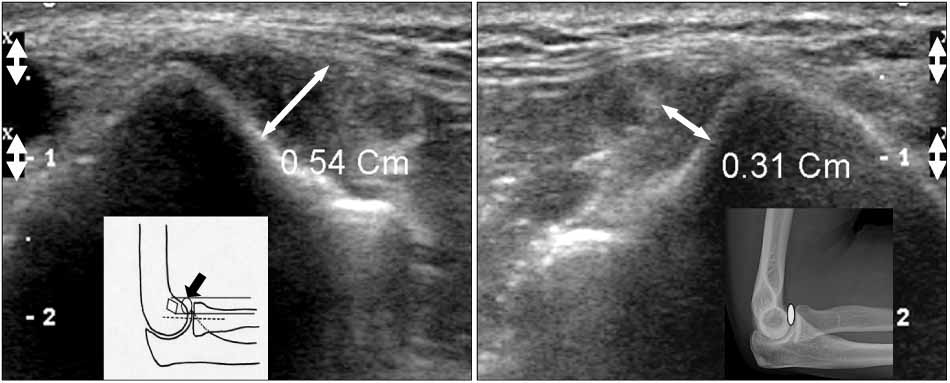J Korean Orthop Assoc.
2009 Oct;44(5):542-547. 10.4055/jkoa.2009.44.5.542.
Ultrasonographic Measurement of Thickness of Extensor Carpai Radialis Brevis Tendons for Lateral Epicondylitis
- Affiliations
-
- 1Department of Orthopaedic Surgery, Soonchunhyang University College of Medicine, Bucheon, Korea. kbsos@schbc.ac.kr
- 2Department of Diagnostic Radiology, Soonchunhyang University College of Medicine, Bucheon, Korea.
- KMID: 2186314
- DOI: http://doi.org/10.4055/jkoa.2009.44.5.542
Abstract
- PURPOSE
To evaluate the ultrasonographic measurements of the thickness of the extensor carpai radialis brevis tendons in patients with lateral epicondylitis. MATERIALS AND METHODS: Twenty nine patients diagnosed with lateral epicondylitis were examined prospectively. Eight were male and twenty one were female. The mean age was 48 (34-62) years. The average time from the onset of symptoms until the examination was 9 (1-24) months. Eighteen patients did not show improvement in their symptoms after conservative treatment. Six underwent arthroscopic debridement and 4 underwent electric shock wave therapy. Three patients showed calcification on the simple x-ray. The thickness of the extensor carpai radialis brevis tendons on both the lesion and contralateral sides was measured and compared using ultrasonography. RESULTS: There were no significant differences in age and gender between the thickness of the extensor carpai radialis brevis tendons on the lesion and contralateral sides (p=0.83, 0.25, 0.80, 0.64). The thickness of the extensor carpai radialis brevis tendons on the lesion and contralateral sides were 4.9 mm and 3.2 mm, respectively, and the lesion side was significantly thicker (p<0.001). The best cut off value of the ECRB thickness at its origin was 3.95 mm, which had a sensitivity, specificity and accuracy of 96.6%, 79.3% and 87.9%, respectively. CONCLUSION: Sonographic measurements of the thickness of the ECRB tendons are valuable for diagnosing lateral epicondylitis.
Keyword
MeSH Terms
Figure
Reference
-
1. Kijowski R, De Smet AA. Magnetic resonance imaging findings in patients with medial epicondylitis. Skeletal Radiol. 2005. 34:196–202.
Article2. Cohen MS, Romeo AA, Hennigan SP, Gordon M. Lateral epicondylitis: anatomic relationships of the extensor tendon origins and implications for arthroscopic treatment. J Shoulder Elbow Surg. 2008. 17:954–960.
Article3. Levin D, Nazarian LN, Miller TT, et al. Lateral epicondylitis of the elbow: US findings. Radiology. 2005. 237:230–234.
Article4. Maffulli N, Regine R, Carrillo F, Capasso G, Minelli S. Tennis elbow: an ultrasonographic study in tennis players. Br J Sports Med. 1990. 24:151–155.
Article5. Struijs PA, Spruyt M, Assendelft WJ, van Dijk CN. The predictive value of diagnostic sonography for the effectiveness of conservative treatment of tennis elbow. AJR Am J Roentgenol. 2005. 185:1113–1118.
Article6. Miller TT, Shapiro MA, Schultz E, Kalish PE. Comparison of sonography and MRI for diagnosing epicondylitis. J Clin Ultrasound. 2002. 30:193–202.
Article7. Martin CE, Schweitzer ME. MR imaging of epicondylitis. Skeletal Radiol. 1998. 27:133–138.
Article8. Connell D, Burke F, Coombes P, et al. Sonographic examination of lateral epicondylitis. AJR Am J Roentgenol. 2001. 176:777–782.
Article9. Nirschl RP. Prevention and treatment of elbow and shoulder injuries in the tennis player. Clin Sports Med. 1988. 7:289–308.
Article10. Pomerance J. Radiographic analysis of lateral epicondylitis. J Shoulder Elbow Surg. 2002. 11:156–157.
Article11. Ohberg L, Lorentzon R, Alfredson H. Neurovascularisation in Achilles tendons with painful tendinosis but not in normal tendons: an ultrasonographic investigation. Knee Surg Sports Traumatol Arthrosc. 2001. 9:233–238.12. Park GY, Lee SM, Lee MY. Diagnostic value of ultrasonography for clinical medial epicondylitis. Arch Phys Med Rehabil. 2008. 89:738–742.
Article13. Zeisig E, Ohberg L, Alfredson H. Extensor origin vascularity related to pain in patients with tennis elbow. Knee Surg Sports Traumatol Arthrosc. 2006. 14:659–663.
Article14. Bunata RE, Brown DS, Capelo R. Anatomic factors related to the cause of tennis elbow. J Bone Joint Surg Am. 2007. 89:1955–1963.
Article
- Full Text Links
- Actions
-
Cited
- CITED
-
- Close
- Share
- Similar articles
-
- Lateral Epicondylitis: Current Concept
- Spontaneous Rupture of the Extensor Carpi Radialis Brevis and Radial Collateral Ligament of the Elbow in a Recreational Golfer: Surgical Experience of Repair of a Chronic Retracted Tendon and Ligament
- Rupture of the extensor carpi radialis longus and extensor carpi radialis brevis tendons following conservative treatment of a distal radius fracture: a case report
- An Extensor Digitorum Muscle for Index Finger Originated from the Extensor Carpi Radialis Brevis
- Ultrasonographic Findings of Lateral Epicondylitis of Humerus



